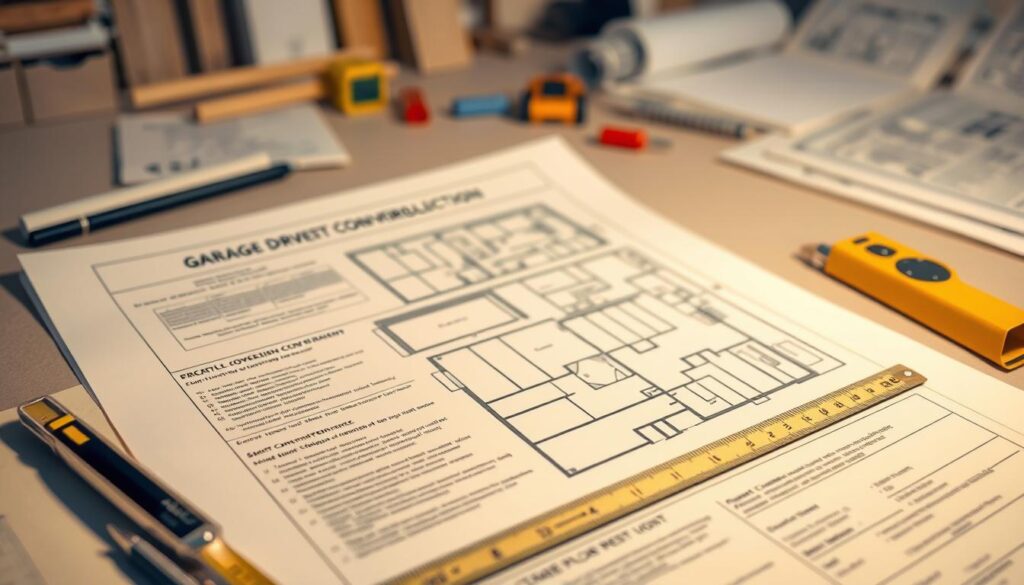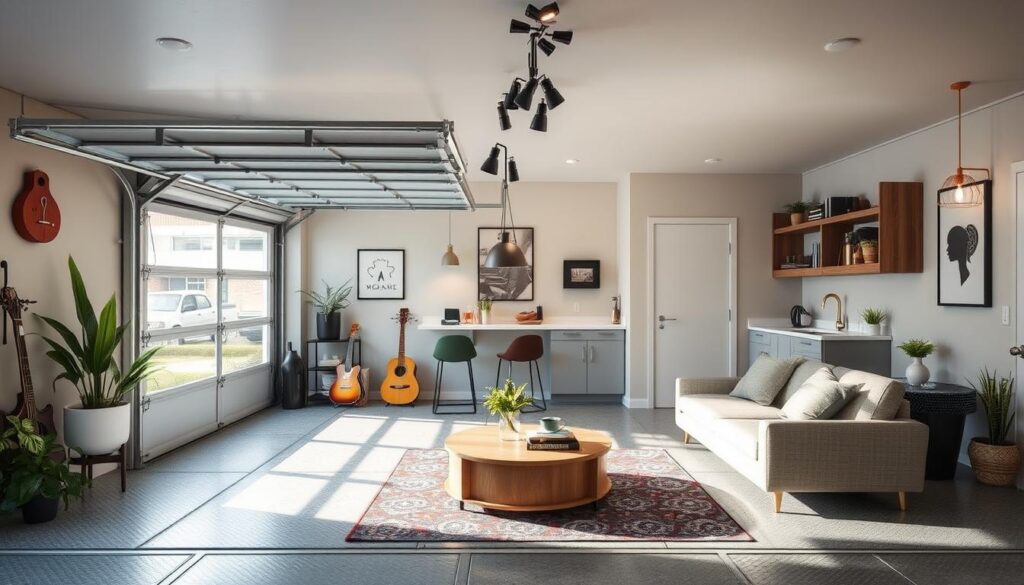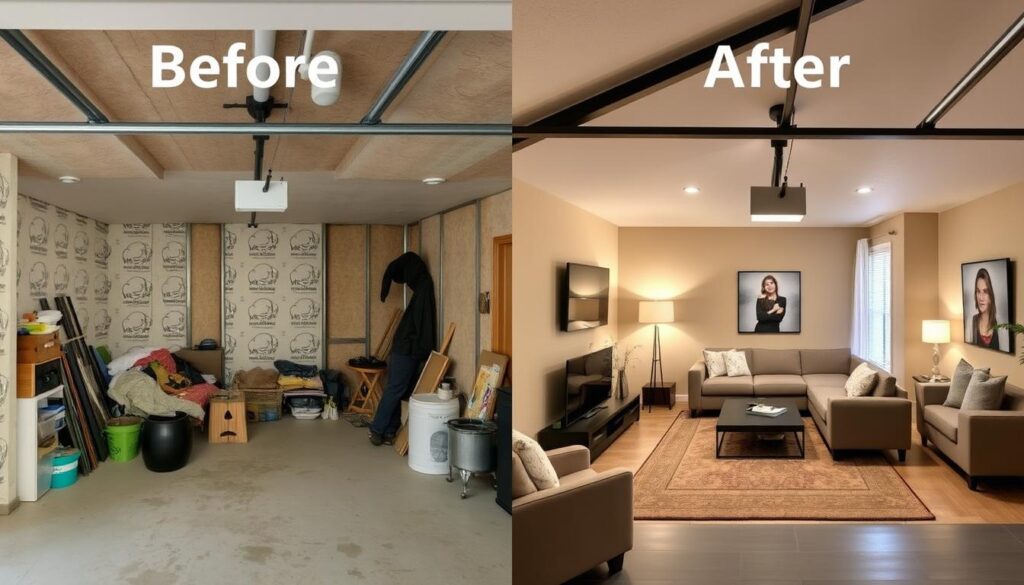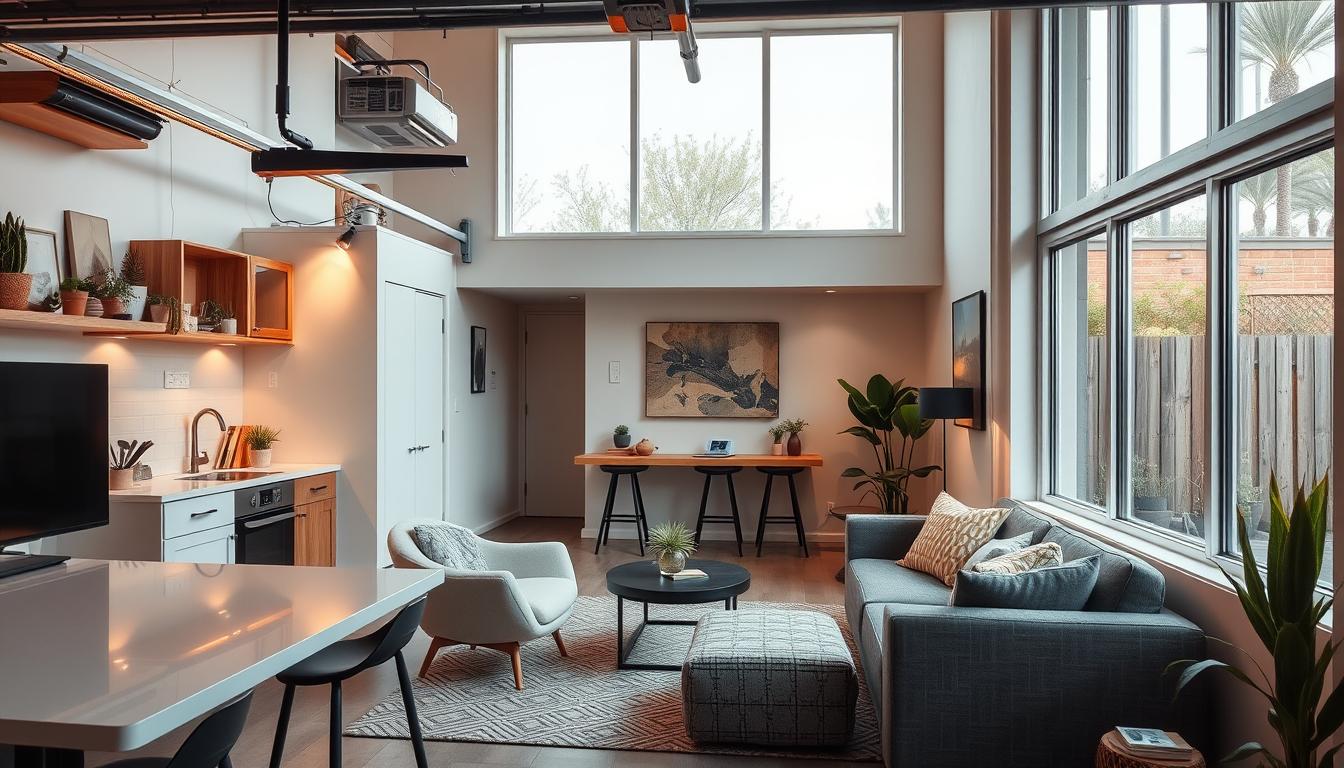Turning your unused garage into a living area is a smart move. It boosts your home’s value and adds useful space. This guide will walk you through the steps, legal needs, and key things to think about. You’ll learn how to make your garage a cozy and inviting place.
Key Takeaways
- Understand the benefits of converting your garage into living space, including increased property value and additional square footage.
- Familiarize yourself with the legal requirements and necessary building permits for a garage conversion project.
- Learn about the essential structural modifications, insulation, and weatherproofing needed to transform your garage.
- Explore the various flooring, wall, and ceiling options to create a cohesive and visually appealing living space.
- Consider the heating, ventilation, and air conditioning needs for your new living area.
Understanding the Benefits of Converting Your Garage
Turning your garage into a living area can change your home for the better. It adds valuable space and boosts your home’s value. Let’s look at the main benefits of making your garage into a living space.
Increased Property Value Benefits
One big reason to convert your garage is to increase your home’s value. Adding a new room or office expands your living space. This can make your home more valuable, which is a smart move for the future.
Additional Living Space Advantages
Expanding your home with a garage conversion gives you more room. You can use it for a guest room, gym, or office. It lets you create the extra space you’ve always wanted.
Cost-Effective Home Expansion
Garage conversions are cheaper than building an addition. They use an existing space, saving you money. This makes it a smart way to grow your living area without breaking the bank.
Choosing to convert your garage offers many benefits. It can increase your home’s value and give you the space you need. Knowing these advantages helps you decide if this renovation is right for you.
Legal Requirements and Building Permits for Garage Conversion
Turning your garage into a living area is thrilling, but you must know the law first. To find out is it legal to convert garage into living space, you need to understand zoning laws, building codes, and permits.
Start by checking with your local government. Make sure converting your garage into living space is okay where you live. Zoning laws can limit what changes you can make, so knowing them is key.
Then, learn about your area’s building codes. These rules cover things like structure, electrical, and plumbing. Following these codes is important for safety and legal reasons.
- Get the right building permits: You might need a permit from your local building office before starting. This involves submitting plans, paying fees, and passing inspections.
- Think about hiring a pro: A licensed contractor or architect can help make sure your garage conversion follows the law. They can help with permits and ensure your project meets standards.
- Stay current: Keep up with local law and building code changes that might impact your garage to living space project. Being informed can prevent legal problems later.
By following the legal rules, you can convert your garage into living space confidently. You’ll know your project is legal and safe.

How to Change Garage to Living Space: Step-by-Step Process
Turning your garage into a living area is exciting and rewarding. To do it right, follow a detailed step-by-step guide. Here’s what you need to think about when how to change garage to living space.
Initial Assessment and Planning
First, check your garage’s current state and layout. Look at the space, structure, and any challenges you might face. This helps you make a plan that meets your needs and goals.
Budget Considerations
- Figure out the costs for renovations like structural changes, electrical and plumbing work, insulation, and finishes.
- Get quotes from licensed contractors to find the best deal.
- Remember to include extra costs like permits, inspections, and unexpected issues.
Timeline Planning
- Make a timeline for the conversion, from planning to finishing touches.
- Talk to your contractor about the project’s length and any possible delays.
- Have a backup plan for any unexpected delays or problems.
By following these steps, you’re on your way to a cozy and useful living space. Stay organized, focus on safety, and work with experts for a successful how to change garage to living space project.

Essential Structural Modifications and Requirements
When you can you convert garage into living space, you must know the key changes needed. These changes turn your garage into a cozy living area. They include foundation upgrades and wall reinforcements for safety and function.
- Foundation Upgrades: Your garage’s foundation might need to be strengthened. This is to handle the extra weight of a living space. You might need a new concrete slab or a stronger foundation.
- Wall Reinforcement: Garage walls aren’t built for insulation and soundproofing like living spaces. You’ll need to add framing, insulation, and drywall. This makes your space comfortable and energy-efficient.
- Ceiling Modifications: You might need to change or raise your garage’s ceiling. This is to meet the height needed for a living space. You could add a new roof or adjust the current structure.
These changes are vital for can you convert garage into living space. They ensure your new space is safe, comfy, and works well. It’s wise to get a professional contractor to check if everything meets local building codes.

“Transforming your garage into a livable space requires careful planning and attention to structural details. These modifications are essential for creating a safe, comfortable, and code-compliant living area.”
Insulation and Weatherproofing Considerations
Turning your garage into a cozy living area requires good insulation and weatherproofing. These steps boost energy efficiency and keep your space warm or cool, no matter the weather.
Wall Insulation Methods
Choosing the right wall insulation is key for comfort and energy savings. Here are some top picks:
- Fiberglass batt insulation: It’s affordable and works well for both heat and sound.
- Spray foam insulation: Though pricier, it fills gaps for a tight seal.
- Rigid foam insulation: It’s top-notch for keeping warmth in and cold out.
Floor and Ceiling Insulation
Don’t forget about the floor and ceiling. They’re just as important for a comfy space. You can use:
- Batt or blown-in insulation in the ceiling
- Rigid foam or radiant floor heating for the floor
- Insulation between the garage ceiling and the space above
Moisture Control Solutions
Moisture can lead to mold and damage. Use ventilation, vapor barriers, and drainage to keep your space dry and healthy.
| Insulation Type | R-Value Range | Advantages | Disadvantages |
|---|---|---|---|
| Fiberglass Batt | R-13 to R-38 | Cost-effective, easy installation | Can be susceptible to air leaks |
| Spray Foam | R-5 to R-7 per inch | Excellent air sealing, high R-value | More expensive, requires professional installation |
| Rigid Foam | R-3.8 to R-8 per inch | High R-value, versatile applications | Can be more costly than other options |
With the right insulation and weatherproofing, your garage can become a cozy, energy-smart living area. It will feel like a seamless part of your home.

Electrical and Plumbing Installation Guidelines
When converting your garage to living space, you must focus on electrical and plumbing systems. It’s important to follow codes and install efficiently. This ensures a safe, functional, and comfy living area.
First, check your current electrical and plumbing setup. This step helps figure out what upgrades you need. Working with licensed pros is key for a smooth changeover.
Electrical System Considerations
- Upgrade the electrical panel to handle the new space’s power needs.
- Put in new outlets, switches, and lights to fit the space’s needs.
- Make sure all electrical work meets local codes and safety rules.
- Think about using energy-saving options like LED lights for better sustainability.
Plumbing Requirements
- Check if your plumbing can handle a bathroom, kitchen, or other water features.
- Install new plumbing lines, fixtures, and drainage as needed.
- Fix any plumbing problems like water pressure or leaks for best performance.
- Check with local authorities to follow building codes and rules.
With careful planning and upgrades, you can turn your garage into a cozy and useful living area. It will meet all safety and building standards.
| Electrical Upgrades | Plumbing Installations |
|---|---|
| Upgrade electrical panel Install new outlets and fixtures Ensure code compliance |
Assess existing plumbing system Install new plumbing lines and fixtures Address any performance issues |
“Proper planning and coordination with licensed professionals are essential to ensure a seamless transition when converting your garage to living space.”
Flooring and Wall Finishing Options
Turning your garage into a cozy living area is all about the flooring, walls, and ceiling. These elements are key to changing the space’s look and feel. Look into various options that boost the room’s beauty, durability, and function for your convert garage to living space before and after project.
Flooring Material Choices
The flooring you pick greatly affects the garage’s vibe. Think about hardwood, laminate, tile, or luxury vinyl plank (LVP) flooring. These choices offer benefits like easy upkeep and better insulation. They make your living space both comfy and welcoming.
Wall Treatment Solutions
Changing the walls can totally alter the room’s feel. Check out drywall, paneling, or exposed brick for a special look. Add a fresh paint or wallpaper to match the walls. This creates a unified and attractive convert garage to living space before and after design.
Ceiling Design Options
- Recessed lighting or track lighting can add a modern and functional touch to the ceiling, providing ample illumination for the new living space.
- Exposed beams or a vaulted ceiling can create a sense of openness and architectural interest, while also contributing to the overall aesthetic of the convert garage to living space before and after transformation.
- Incorporating decorative elements like crown molding or a statement light fixture can elevate the ceiling design and tie the entire space together.
Choosing the right flooring, wall treatments, and ceiling design is crucial. It turns your old garage into a stunning and useful living area. This area will blend perfectly with your home.
Heating, Ventilation, and Air Conditioning Systems
Converting your garage into a living space means you need to think about the HVAC system. It’s key to have a comfy and energy-saving space all year. This is vital for your new living area.
First, you must figure out the right size for your HVAC system. How to change garage to living space often means you need a bigger system. This ensures the space is well-heated and cooled.
Also, where you put the HVAC parts matters a lot. It affects how the space looks and works. You need to plan well to fit the ductwork, vents, and controls smoothly into your new area.
Heating Solutions
Choosing a heating system depends on your area’s weather and what you like. You might pick a special heating system for the garage or use your home’s. Here are some options:
- Forced-air heating systems
- Radiant floor heating
- Wall-mounted heaters
- Baseboard heating
Cooling and Ventilation
Good cooling and air flow are key for a comfy living space, especially in warm weather. You might consider:
- Getting a dedicated air conditioner
- Connecting the garage to your home’s air system
- Adding ceiling fans or wall fans
- Using windows, doors, or exhaust systems for air flow
Thinking carefully about your garage’s HVAC needs helps make a cozy and energy-saving space. It will blend well with your home.
Windows and Doors: Installation and Placement
Choosing the right windows and doors is key to making your garage a living space. By placing them wisely, you can let in more natural light and air. This makes your new area bright, airy, and easy to move around in.
Natural Light Solutions
Adding natural light to your garage makes it feel welcoming and bright. Think about installing big windows, French doors, or a skylight. This lets sunlight in and makes your space more inviting.
When picking where to put these light sources, think about your garage’s layout. Choose spots that fit well with your design and make the most of the natural light.
Entry Point Planning
Where you put doors and entryways affects how you use your garage. Think about moving the garage door to a spot that looks better with your home. This can make your garage feel more connected to the rest of your house.
Also, consider adding extra doors. Side or rear doors can give you easy access and more privacy when you need it.





